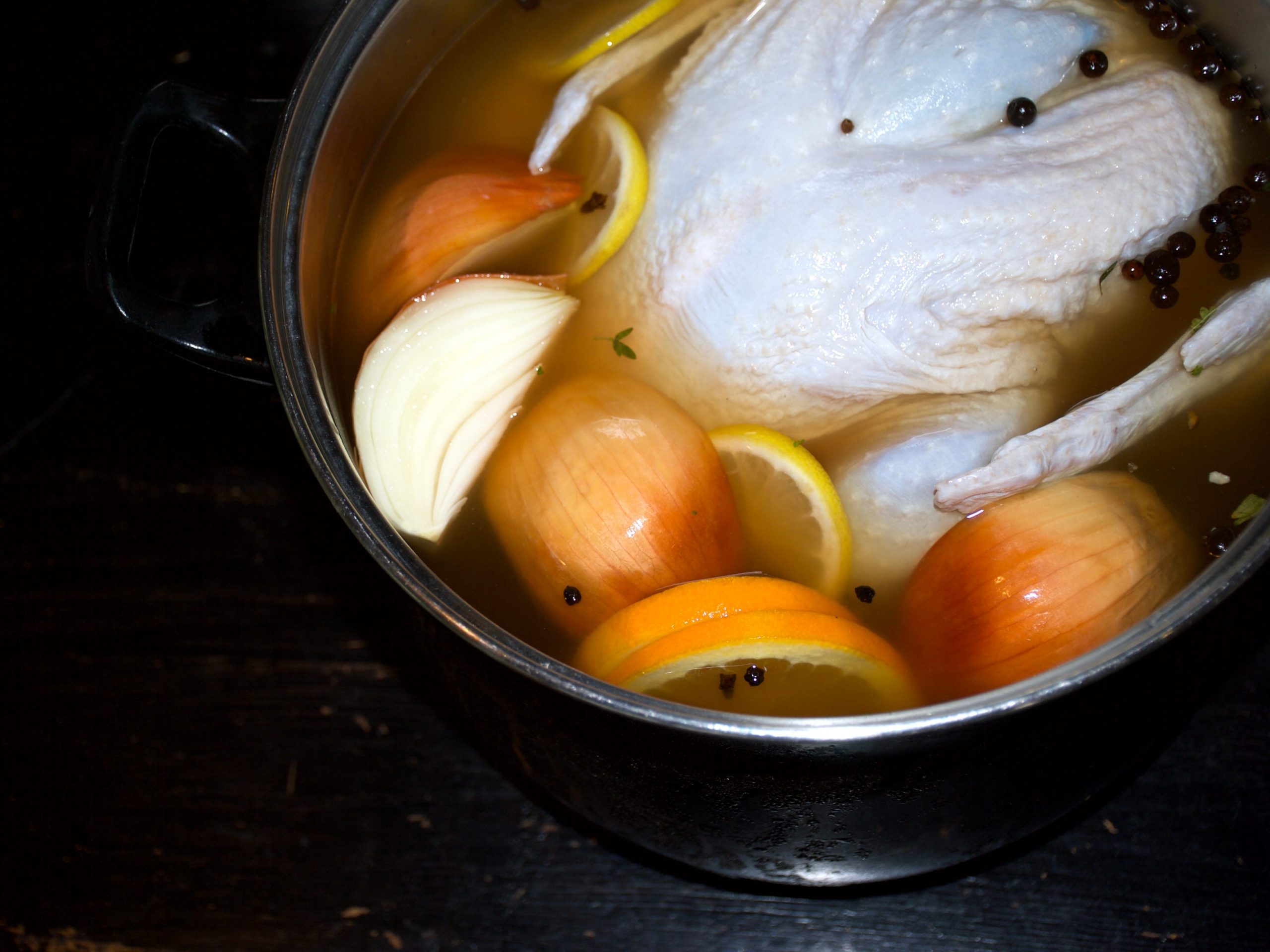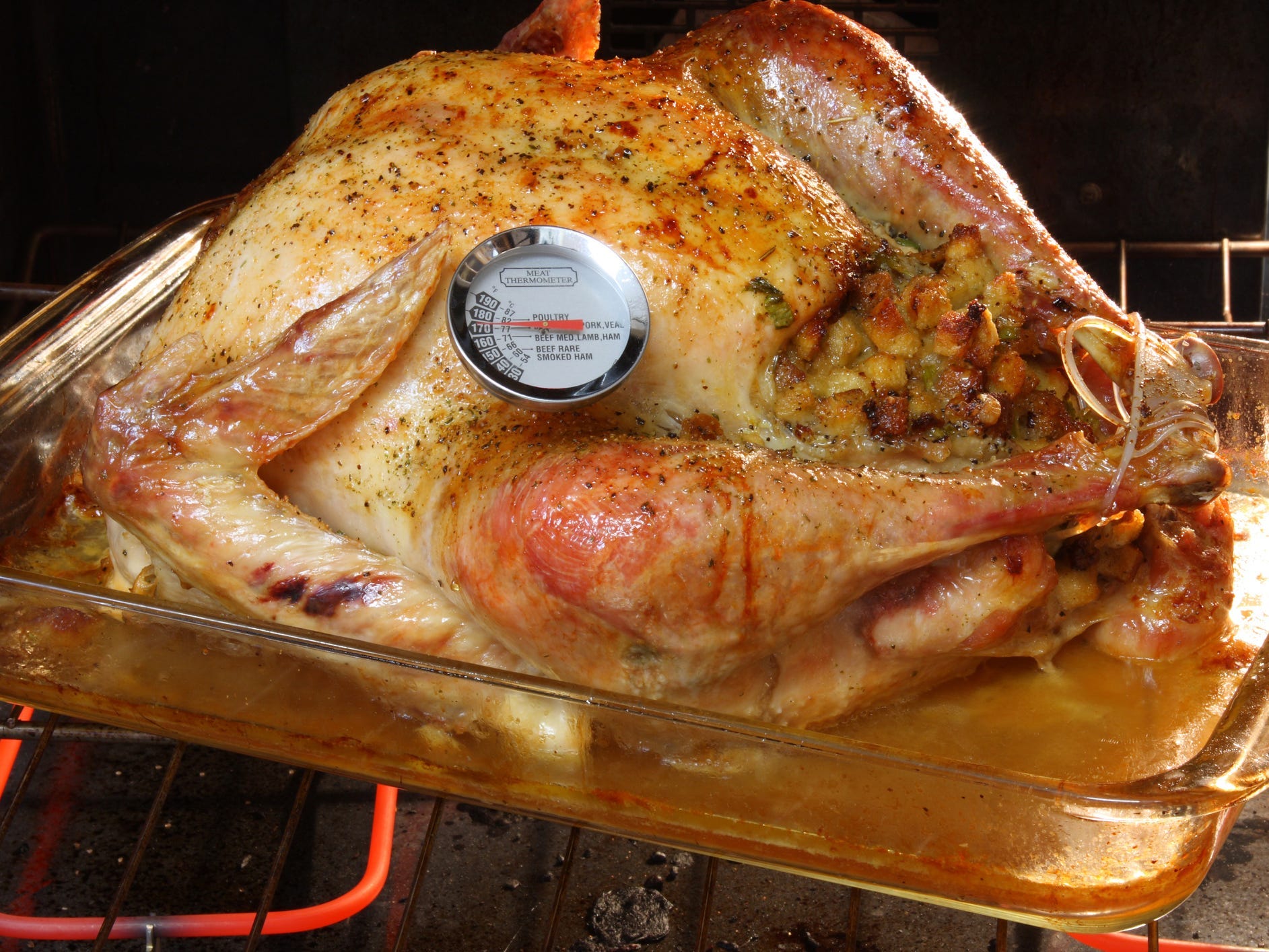
- Experts say to plan for about 1 ¼ pound of turkey per person.
- The cooking time for turkey ranges from 2 ¾ hours to 5 ¼ hours minutes, depending on its weight.
- Turkey is safe to eat once it's reached 165 degrees Fahrenheit — and that includes the stuffing.
- Visit Insider's Home & Kitchen Reference library for more stories.
Whether you're hosting an intimate dinner for two or a feast for twenty, there are a few key things to keep in mind when cooking a turkey. For one, you'll want to prioritize food safety when it comes to thawing, roasting, and storing the meat for the sake of you and your family. Of course, you also want to ensure that you never compromise flavor in the cooking process.
Especially if this is your first time cooking a turkey, you may find that you have a lot of questions along the way. Below, Herve Malivert, director of culinary affairs at the Institute of Culinary Education, and Yannick Tirbois, chef-instructor at Le Cordon Bleu, address all the most common questions about cooking a tender, flavorful turkey.
How big of a turkey do I need?

Figuring out how much turkey you'll need isn't always easy. After all, you can't predict exactly how much everyone will eat — and some guests may go back for seconds or thirds. That said, Tirbois says 1 ¼ pound per person is a good benchmark to guarantee all your guests have a satisfying portion.
"I prefer to buy small turkeys, about 12 to 15 pounds maximum," adds Malivert. "This size can easily serve 10 to 12 people."
According to Malivert, smaller turkeys tend to have juicier, more tender meat because they're younger.
When and how should I thaw the turkey?
If you're dealing with a frozen bird that weighs between 12 and 16 pounds, Malivert advises transferring it from the freezer to the refrigerator three days before you plan to cook it — so in the case of Thanksgiving, on the Monday before the holiday. Place it in the fridge in a large container that will catch any stray juices as it thaws.
Since the size of the turkey can factor into how long it takes to defrost, Tirbois says to plan for 24 hours of defrosting per 5 pounds of meat. For example, a 20-pound turkey would take about four days to defrost in the fridge.
If you find the turkey is still frozen in spots even after spending time in the fridge, Malivert says you can let it sit on the counter for a maximum of two hours the morning you plan to cook it. This is the safest method for thawing a turkey.
If your bird is still frozen by the time you need to start cooking, Tirbois recommends thawing it in cold water, which will take about 30 minutes per pound. Place the turkey in a leak-proof plastic bag to avoid cross-contamination and prevent the meat from absorbing water, then submerge it in a sink or large pot filled with cold tap water. Change the water every 30 minutes to ensure it stays within a safe temperature range, says Tirbois.
How long can a thawed turkey stay in the fridge?
According to experts, a turkey can be stored safely in the fridge for two days after it's fully thawed.
Do I need to clean a turkey?
The USDA advises against rinsing a turkey. According to Tirbois, this is because washing the bird could increase the possibility of cross-contamination and spread bacteria. The water you use to rinse the bird could easily splash onto other surfaces in your kitchen, carrying dangerous bacteria with it. There's no need to rinse the surface of the turkey — cooking it properly is the best way to get rid of harmful bacteria.
However, you should remove the giblets if they're still inside. Make sure the bird is fully thawed before reaching into the front and back cavities to take them out by hand or with tongs. Typically, butchers wrap the giblets in paper or plastic. While you can certainly throw the giblets away, Tirbois recommends using them to add a rich flavor to your gravy.
Do I need to brine a turkey?

While experts agree that brining is not necessarily a must, they say there are a few benefits to adding this extra step.
"Brining the turkey will season the meat, keep it tender, add color, and clean the skin," explains Malivert.
Tirbois adds that when you wet brine a turkey, it will usually absorb moisture from the liquid, resulting in juicier meat.
The only potential disadvantage to brining, according to Malivert, is that you'll need a large amount of space in your fridge to store the pot if you plan to soak it.
How do I stuff a turkey safely?

According to the Centers for Disease Control and Prevention (CDC), the best way to make sure that the stuffing is cooked thoroughly is to bake it separately from the turkey.
Place the stuffing in a separate casserole dish, and after cooking, use a food thermometer to ensure that the center is 165 degrees Fahrenheit — the CDC notes that if it does not reach that temperature, bacteria that are known to cause food poisoning may survive.
If you'd rather roast the stuffing inside the turkey, the CDC recommends waiting 20 minutes after you take the bird out of the oven before scooping the stuffing out so that it can cook a bit longer as the turkey rests. It needs to reach an internal temperature of 165 degrees Fahrenheit to be safe to eat.
Another safe option, says Malivert, is to stuff your turkey with a vegetarian medley of cornbread, fennel, onion, and mushroom. Then, cook sweet sausage meat on the stovetop with more onion, garlic, and white wine — and combine that meat with the cornbread stuffing, butter, and juice from the turkey before serving.
At what temperature should I cook the turkey?
Tirbois recommends roasting the turkey at 410 degrees Fahrenheit for the first 30 minutes and then lowering the temperature to 350 degrees Fahrenheit for the remainder of the cooking time. This method will yield moist and tender meat on the inside, but with crispy golden skin on the outside.
How long should I cook the turkey?
The chart below includes the USDA's recommendations for the ideal cooking time based on the weight of your turkey.
| Weight | Cooking time (unstuffed) | Cooking time (stuffed) |
| 8 to 12 pounds | 2 hours and 45 minutes to 3 hours | 3 hours to 3 hours and 30 minutes |
| 12 to 14 pounds | 3 hours to 3 hours and 45 minutes | 3 hours and 30 minutes to 4 hours |
| 14 to 18 pounds | 3 hours and 45 minutes to 4 hours and 15 minutes | 4 hours to 4 hours and 15 minutes |
| 18 to 20 pounds | 4 hours and 15 minutes to 4 hours and 30 minutes | 4 hours and 30 minutes to 4 hours and 45 minutes |
| 20 to 24 pounds | 4 hours and 30 minutes to 5 hours | 4 hours and 45 minutes to 5 hours and 15 minutes |
Do I need to baste the turkey?

Basting — which entails brushing or spooning the pan juices back over the turkey while it cooks — can keep the meat moist and flavorful, add color and crispness to the skin, and even help it to cook more evenly, says Malivert.
According to both Tirbois and Malivert, you should baste your turkey every 30 minutes for best results — and move quickly, as keeping the door open for too long will cause the temperature of the oven to drop.
What temperature should a turkey be when it's done?
Your turkey is done cooking when it reaches an internal temperature of 165 degrees Fahrenheit.
How do I use a meat thermometer to check for doneness?

Malivert recommends checking the temperature by inserting a food thermometer into several different areas to confirm that they've all cooked evenly. Insert the thermometer into the thickest part of the thigh, breast, and wing joint. If you cooked your turkey with stuffing inside, remember to also do a temperature read on the center of the stuffing to ensure it's reached the same temperature. The temperature should read 165 degrees Fahrenheit at every insertion point.
How long is leftover turkey good for?

For safety reasons, it's crucial to store leftover turkey in the fridge — because Clostridium perfringens bacteria, a common cause of food poisoning, thrives in cooked food that's left at room temperature, according to the CDC.
The CDC recommends slicing up big cuts of meat into smaller pieces so they can cool down faster before storing the turkey in the fridge. Any meat that's left out at room temperature for more than two hours should be thrown out.
Experts say leftover turkey can last in the fridge for up to three or four days if stored in an airtight container in the refrigerator. When reheating the turkey, always be sure that it reaches 165 degrees Fahrenheit again before serving.
Can I freeze leftover turkey?
Leftover turkey can be frozen in airtight plastic bags for up to three months, says Tirbois. He suggests removing the bones from the meat before freezing it.
However, Malivert notes that reheating frozen turkey may take a toll on the texture — causing it to dry out. Adding butter and/or stock can help to lock moisture in as you reheat it.
Insider's takeaway
When it comes to food safety, there are several important things to remember: only keep uncooked turkey in the fridge for two days after it's thawed, don't bother washing it, and use a meat thermometer to make sure both the meat and stuffing have reached an internal temperature of 165 degrees Fahrenheit after cooking. Also, leftover turkey needs to be refrigerated at 40 degrees Fahrenheit or below within two hours and consumed within three to four days.
As far as flavor goes, chefs' top tips include brining and basting the turkey and reducing the oven temperature from 410 degrees to 350 degrees after the first 30 minutes of cooking to achieve both crispy skin and tender meat.
